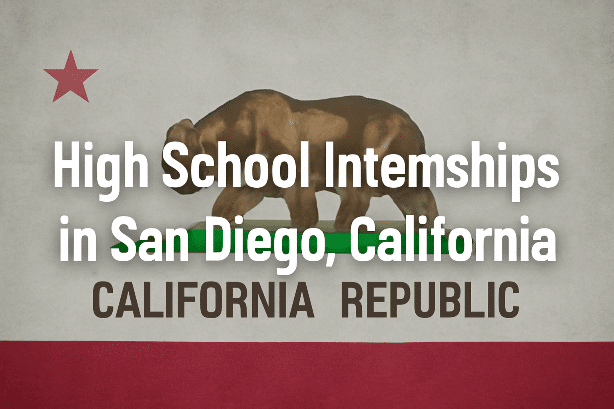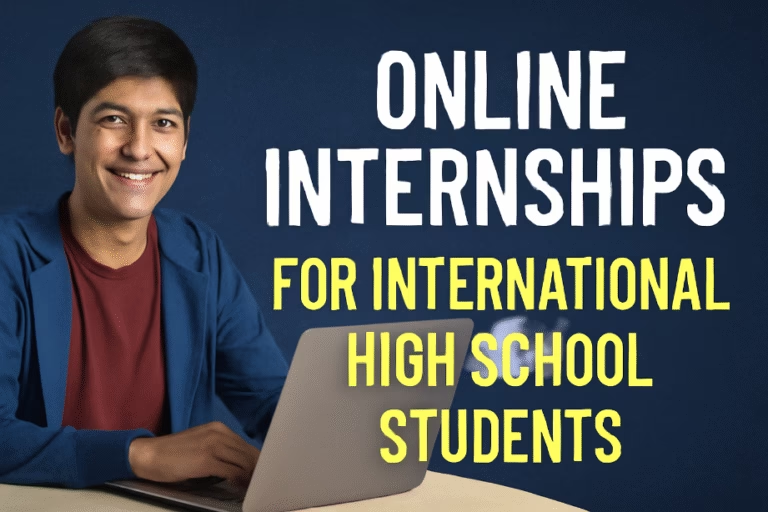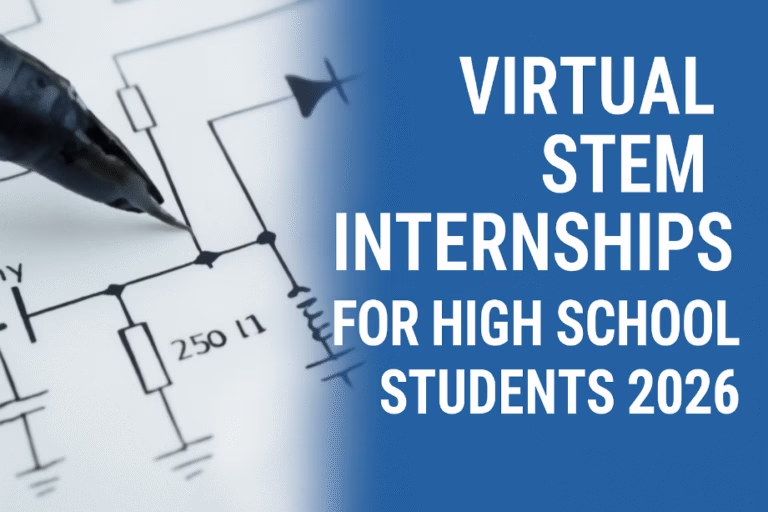15 Best Online Summer Internships for High School Students 2026
Online Summer Internships for High School Students — 2026
Online summer internships give high school students the chance to gain meaningful experience, build a portfolio of real deliverables, and connect with mentors from leading research labs, universities, and global organizations — all without relocation. For 2026, several reputable institutions offer high-quality virtual internships, research assistantships, or mentor-led project fellowships that are especially suitable for ambitious teens. Below you’ll find 15 vetted programs from well-known institutions, each with an official link, eligibility notes, payment information (where applicable), location details, and typical application windows.
Use this guide to shortlist 3–5 programs that match your interests (STEM research, AI, public health, conservation, finance, or open-source engineering).

How I selected programs
Entries below are drawn only from established universities, government research organizations, major NGOs, or widely recognized national programs (e.g., NASA, Harvard, Stanford, Smithsonian, CERN, WHO). Each listing links to the program’s official page so you can confirm eligibility and deadlines directly.
Top 15 reputable online summer internship programs for high school students — 2026
-
1. NASA — High School Virtual Tracks & Education Internships
Official link: NASA High School Aerospace Scholars (HAS) and NASA Student Internships.
Description: NASA runs a range of high-school–focused virtual learning tracks (HAS, GeneLab for High Schools) and center-led student internships that include remote research or project-based placements in data analysis, engineering design challenges, and space-biology datasets. These virtual tracks are explicitly designed to give students deeper exposure to aerospace and STEM research without traveling to a center.
Requirements: Varies by program; some tracks require U.S. residency/citizenship while others (educational modules) are broadly accessible. Always confirm eligibility on the official page.
Paid/Unpaid: Many NASA student programs and internships offer stipends for eligible participants; educational modules are often free. Verify the specific offering for stipend details.
Location: Virtual (with optional in-person capstones for select cohorts).
Timeline: Application windows commonly open in fall/winter for summer activities; check the NASA STEM Gateway and center pages for 2026 dates.
-
2. Google — Computer Science Summer Institute (CSSI) & Virtual Outreach Programs
Official link: Google CSSI and Google student outreach pages.
Description: Google’s CSSI is an intensive program for graduating high-school seniors (and rising college freshmen) that offers virtual cohorts focused on foundational computer science, project work, and mentorship. While some of Google’s internship tracks are for university students, CSSI and related outreach cohorts provide strong remote learning and exposure to industry mentors.
Requirements: Often targeted at high-school seniors and underrepresented students in tech; review current eligibility each year on Google’s site.
Paid/Unpaid: CSSI is frequently offered at no cost and historically includes support for participants; it is an educational program rather than a paid work internship. For paid internship opportunities proper, employers generally require university status; still, CSSI is a high-value, funded pathway into industry.
Location: Virtual or hybrid cohort formats as announced per year.
Timeline: Application windows typically open in late winter; check the program page for exact dates.
-
3. Smithsonian Institution — Online Internships & Virtual Research Projects
Official link: Smithsonian Learning Lab and Smithsonian internship pages (National Museum of Natural History summer high school internships listing).
Description: The Smithsonian offers virtual curation, science-communication, digital-collections projects, and the NMNH Summer High School Internship (virtual components vary by year). These are excellent for students interested in museum science, collections research, and public-facing STEM communication.
Requirements: Many Smithsonian modules are open to global audiences; formal internships (NMNH, SSEC) list age/grade requirements (commonly 14–18) on the official listings.
Paid/Unpaid: Most virtual learning modules are unpaid; selective summer internship tracks may provide small stipends or academic credit. Check the program page for the exact offer.
Location: Virtual (with occasional hybrid or on-site components depending on the specific internship).
Timeline: Many virtual modules accept rolling sign-ups; formal summer internships post application windows in winter/spring.
-
4. Johns Hopkins CTY — Virtual Research & Pre-College Modules
Official link: Johns Hopkins Center for Talented Youth (CTY)
Description: CTY’s online courses and pre-college tracks include short research modules and mentor-guided projects in STEM and other disciplines. For students seeking academic-mentored summer work, CTY provides rigorous online options that produce strong portfolio pieces.
Requirements: Grade- or aptitude-based eligibility varies by course; check CTY course pages for grade-level and testing prerequisites.
Paid/Unpaid: Tuition-based (fee) for many CTY pre-college courses; scholarships and financial aid are sometimes available.
Location: Fully virtual options available.
Timeline: Online course registration and summer program sign-ups usually appear in winter/spring.
-
5. Stanford Pre-Collegiate Summer Institutes — Online Single-Subject Courses
Official link: Stanford Pre-Collegiate Summer Institutes
Description: Stanford runs single-subject online courses (science, engineering, AI, bioscience) for grades 8–11, with mentored projects and final deliverables—suitable for ambitious high schoolers who want a structured academic summer with faculty-level instructors.
Requirements: Students in specified grade ranges; course prerequisites vary by subject.
Paid/Unpaid: Fee-based programs; financial aid may be offered for eligible families.
Location: Online.
Timeline: Applications open in winter for summer sessions.
-
6. Harvard Pre-College & Harvard Online — Virtual Summer Academics
Official link: Harvard Pre-College Program
Description: Harvard’s pre-college and online summer offerings include short virtual intensives and mentored course projects that produce portfolio-ready work and letters of recommendation for participants. These are selective and academically rigorous.
Requirements: Varies by program; many programs target rising juniors/seniors with strong academic records.
Paid/Unpaid: Tuition-based; financial aid may be available.
Location: Virtual and residential options (virtual tracks are ideal for remote internships/summer work).
Timeline: Deadlines usually fall in winter or spring. :
-
7. Columbia University — Online Summer Research & Pre-College Modules
Official link: Columbia Pre-College Online Summer
Description: Columbia’s School of Professional Studies offers online courses and mentored project modules for high-school learners, including data-, research-, and writing-intensive tracks with faculty and graduate student mentors.
Requirements: Selective; program prerequisites vary by course.
Paid/Unpaid: Tuition-based; scholarships may be available for qualified students.
Location: Online.
Timeline: Applications open in winter for summer cohorts.
-
8. Oxford Scholastica Academy — Online Research Internships
Official link: Oxford Scholastica — Online Internships
Description: Oxford Scholastica runs mentored online research internships where students work with an expert mentor on a publishable paper or research report (medicine, politics, law, business). These produce portfolio outputs and academic endorsements.
Requirements: Commonly ages 15–18 with strong academic interest in the research topic.
Paid/Unpaid: Fee-based; scholarships and bursaries sometimes available.
Location: Virtual.
Timeline: Sessions in July–August; deadlines in spring.
-
9. CERN — Virtual Student Activities & Remote Challenges
Official link: CERN Students & Educators
Description: While CERN’s formal summer student program targets university students, CERN publishes virtual outreach activities, remote design challenges, and webinar series suitable for talented high-schoolers with strong physics/maths interest. These programs provide mentorship exposure to large-scale physics experiments and computational analysis.
Requirements: Depends on activity—virtual challenges generally welcome advanced high-school students; check each call.
Paid/Unpaid: Virtual outreach is typically unpaid/educational; formal CERN student programs may offer stipends for eligible participants.
Location: Virtual (Geneva-based in-person programs exist for older students).
Timeline: Calls and webinars released year-round; subscribe to CERN education newsletters.
-
10. Outreachy & Google Summer of Code (Open-Source Remote Projects)
Official links: Outreachy and Google Summer of Code (GSoC)
Description: Outreachy provides paid open-source internships with remote mentorship for underrepresented groups (18+), producing measurable code contributions. GSoC pairs students with open-source organizations for paid project work; eligibility varies year to year and is often aimed at university students but some high-schoolers (typically 16+) participate depending on program rules. Both produce portfolio-grade outcomes and are internationally respected.
Requirements: Outreachy requires applicants to be 18+ and meet the program’s underrepresented-group criteria; check GSoC eligibility each cycle.
Paid/Unpaid: Paid stipends on successful completion.
Location: Fully remote.
Timeline: Annual application windows (early-year announcements for summer cohorts).
-
11. Fred Hutch — Summer High School Internship Program (SHIP) with Hybrid/Remote Options
Official link: Fred Hutch — SHIP
Description: Fred Hutch’s SHIP is a competitive, paid summer research program for high-school juniors and seniors; in recent cycles, hybrid and remote components have been included for data-analysis and bioinformatics projects. This is an excellent paid research pathway for students aiming for biomedical research experience.
Requirements: High-school junior or senior; selection is competitive and application materials are required.
Paid/Unpaid: Paid stipend for accepted participants.
Location: Seattle-based with remote/hybrid options as announced.
Timeline: Applications typically open in winter for summer cohorts.
-
12. St. Jude Children’s Research Hospital — High-School Internships & Virtual Tracks
Official link: St. Jude — Education & Internships
Description: St. Jude offers immersion programs and selected internship tracks that include research-assistant tasks and information-services projects. Some roles incorporate remote data and literature-analysis components appropriate for high-school participants.
Requirements: Program-dependent; many tracks serve seniors or recent grads; check the official pages for age and eligibility.
Paid/Unpaid: Select programs provide stipends; check each listing for details.
Location: Primarily Memphis, TN, with virtual elements possible.
Timeline: Deadlines usually occur in winter/spring for summer positions.
-
13. Virtual Internships (Placement Platform — Employer Designed Remote Internships)
Official link: The Forage (virtual work experiences) and VirtualInternships.com
Description: The Forage offers free, employer-designed virtual work experiences (Citi, BCG, Deloitte, JPMorgan, etc.) that simulate day-to-day tasks and produce completion certificates. VirtualInternships.com provides paid and unpaid remote placement services with vetted host companies. Both are strong ways to gain product- or business-focused project experience remotely.
Requirements: Varies by module/host; many Forage simulations are open to high school students.
Paid/Unpaid: Forage modules are free and certificate-based; Virtual Internships listings are mixed — some host employers pay. Check each host posting.
Location: Remote / self-paced.
Timeline: Year-round availability — ideal for summer self-study or stacked module completion. 14. Ladder Internships & CodeDay Labs — Cohort-Based Remote Tech Internships for Teens
- Official links: Ladder Internships and CodeDay LabsDescription: Ladder runs cohort-based remote internships in product, growth, and software; CodeDay Labs places teens into mentored software projects. Both produce mentor feedback, demo days, and deliverables for portfolios. These programs are reputable choices for high-schoolers seeking practical coding or startup experience online.
Requirements: Varies by cohort; portfolio or demonstrated interest recommended.
Paid/Unpaid: Some cohorts offer stipends or paid placements; other cohorts are low-cost with strong outcomes. Check current cohort announcements.
Location: Remote cohorts.
Timeline: Multiple cohorts throughout the year with summer intensives.
-
15. University-Affiliated Short Research Internships & Summer Schools (e.g., Oxford / University Summer Schools)
Official links: Oxford University – Pre-University Summer Schools, and other major universities’ pre-college online tracks (example: Oxford Scholastica above, Harvard/Stanford/Columbia referenced earlier).
Description: Many top universities offer online research intensives, virtual lab simulations, and pre-college research projects (economics, computer science, bioscience). These produce academic reports, faculty feedback, and strong university-brand recognition on applications. :contentReference[oaicite:36]{index=36}
Requirements: Typically selective; academic prerequisites and grade-level requirements vary by program.
Paid/Unpaid: Mostly tuition-based, though scholarships and bursaries may be available for eligible students.
Location: Virtual.
Timeline: Deadlines in winter/spring for summer sessions.

How to choose the right online summer internship
Picking the right program comes down to three practical criteria:
- Deliverables: Prefer internships that result in a tangible outcome — code on GitHub, a research poster, a written report, or a demo video you can show in college applications.
- Mentorship frequency: Programs with weekly mentor check-ins accelerate learning and produce stronger recommendation letters.
- Eligibility & cost: Confirm age, nationality, and fee policies early. If cost is a barrier, prioritize free or scholarship-supported options (e.g., certain NASA modules, Google CSSI, outreach programs, or open-source stipends like Outreachy).
Application checklist & sample timeline (for a June start)
Use this timeline to prepare and submit 3–5 competitive applications:
- September – November (prior year): Research programs and shortlist 3–5 fits. Start small projects you can include in your portfolio (simple data analysis, a mini research literature review, or a coding mini-app).
- December – February: Draft personal statements, update your 1-page resume, and request two recommendations (STEM teacher + mentor). Complete any required tests or application forms.
- March – April: Finalize and submit applications for most university and NGO summer programs. Prepare a short project plan you can include as part of your application (3–6 bullet points describing initial steps and deliverables).
- May – June: Accept offers, complete onboarding, and set up your workspace (reliable internet, camera, microphone, collaborative tools).
What to include in your application
- One-page resume: Focus on projects, clubs, and any relevant coursework or self-study (online course certificates, GitHub links).
- Short personal statement (300–500 words): Mention a concrete learning goal and the deliverable you plan to produce (e.g., “I will analyze X dataset and produce a reproducible Jupyter notebook and a 2-page summary suitable for a research poster”).
- Portfolio links: GitHub, Google Drive project PDFs, or a short demo video (1–3 minutes).
- Recommendation: One teacher or mentor who can attest to your technical curiosity and reliability.
- Availability calendar: Clear weekly hours you can commit during the summer.
Sample outreach email (if you plan a self-directed or small host internship)
Subject: Remote Research/Project Proposal — [Your Name] Hello [Dr./Mr./Ms. Lastname], My name is [Your Name], a rising [grade/year] at [School]. I’m passionate about [topic], and I’d like to propose a short remote research project to support [Department/Company]. My 6-week plan would deliver a reproducible analysis (Jupyter notebook) and a 5-page research summary. I can commit [x] hours/week and would welcome brief weekly check-ins with a mentor. Would you be open to a 10-minute call to discuss a pilot? Sincerely, [Your Name] — [email] — [phone]
Deliverables to aim for by the end of a summer online internship
- Working code (GitHub) or reproducible analysis with a clear README.
- A 1,000–1,500 word research summary or technical write-up.
- A slide deck or 3–5 minute video demo presenting your findings.
- At least one mentor endorsement or letter of recommendation.
Frequently Asked Questions (FAQs)
1. Are these online internships competitive?
Yes — programs offered by major institutions (NASA, Harvard, Stanford, Fred Hutch, St. Jude) are competitive because they combine mentorship with tangible outcomes and often have limited cohort sizes. Apply early and include clear project evidence in your application.
2. Can international students apply?
Many virtual programs accept international applicants (Harvard, Stanford, Columbia, Oxford Scholastica, CERN webinars, Outreachy/GSoC for open-source). However, certain national programs (some NASA internships or regionally funded fellowships) may have citizenship or residency rules — always check the official eligibility notes.
3. Do these online internships pay?
Payment varies. Outreachy and some open-source stipends pay participants; Fred Hutch SHIP and other university research internships have stipends for participants; many university pre-college courses are tuition-based (fee). NASA and certain research centers may offer stipends for specific intern roles — verify each program’s payment policy on its official page.
4. How many hours per week should I expect to commit?
Expect 5–20 hours per week for most virtual internships. Intensive bootcamps or full-time research programs will require more (20–40 hours/week). Confirm the expected weekly commitment before accepting an offer to avoid schedule conflicts.
5. How do online internships compare to in-person internships?
Online internships often emphasize analysis, coding, literature review, simulations, and digital deliverables. They can be just as rigorous and valuable as in-person internships if they include structured mentorship, concrete deliverables, and final presentations. For lab-based wet-lab experience, in-person internships remain important — but many labs now provide remote data-analysis tracks that are highly useful for students.
6. How do I verify a program’s legitimacy?
Check that the program is hosted by an established institution (university, government lab, or major NGO), look for clear contact information, read past participant testimonials, and confirm whether the program provides a written scope of work or syllabus. Avoid programs that ask for large upfront fees without a clear refund policy and documented program structure.
Related posts
See our other curated guides for more targeted opportunities: Virtual STEM Internships for High School Students 2026, Paid Remote Internships for High School Students 2026, and Online Paid Internships for High School Students 2026.










One Comment